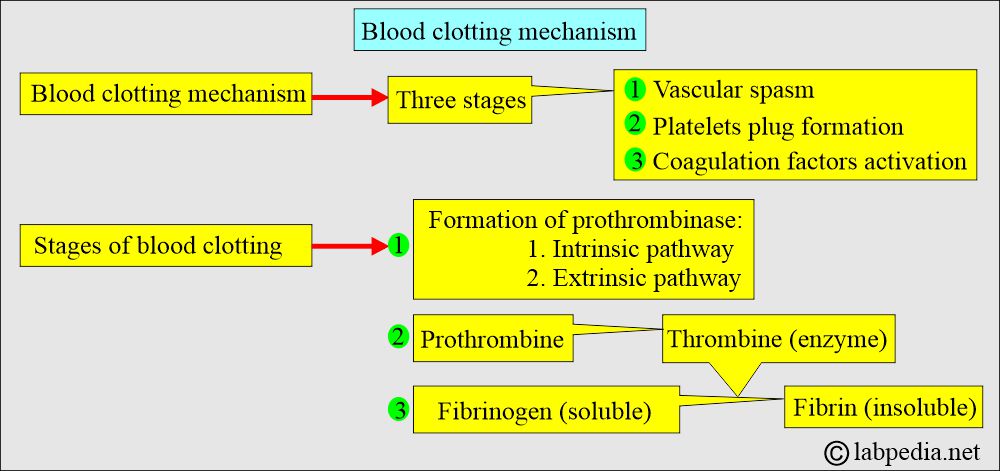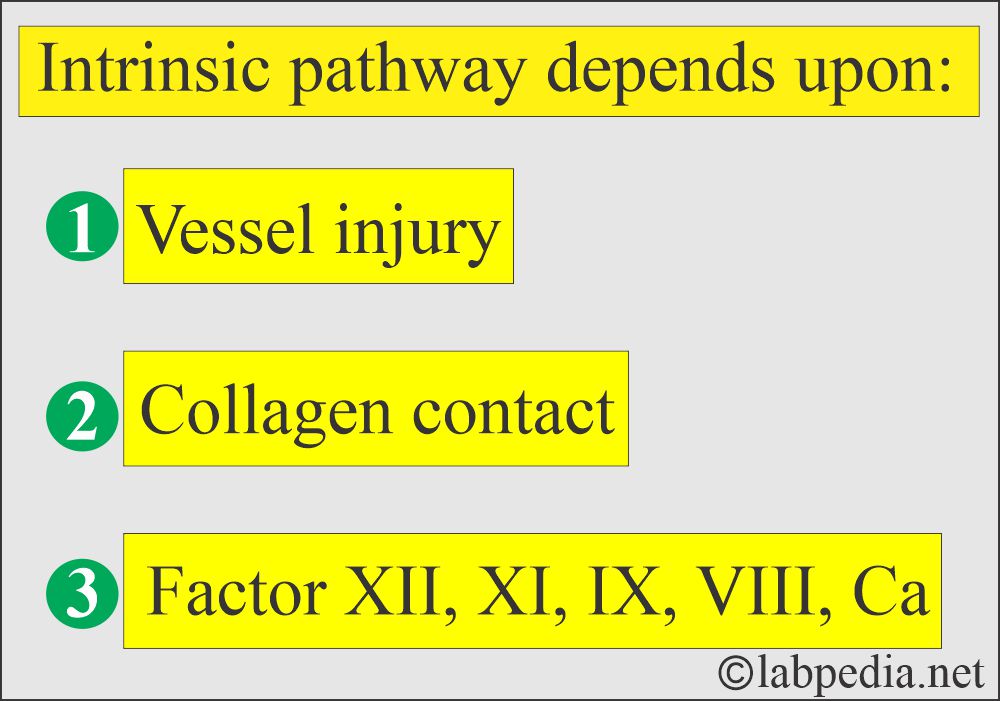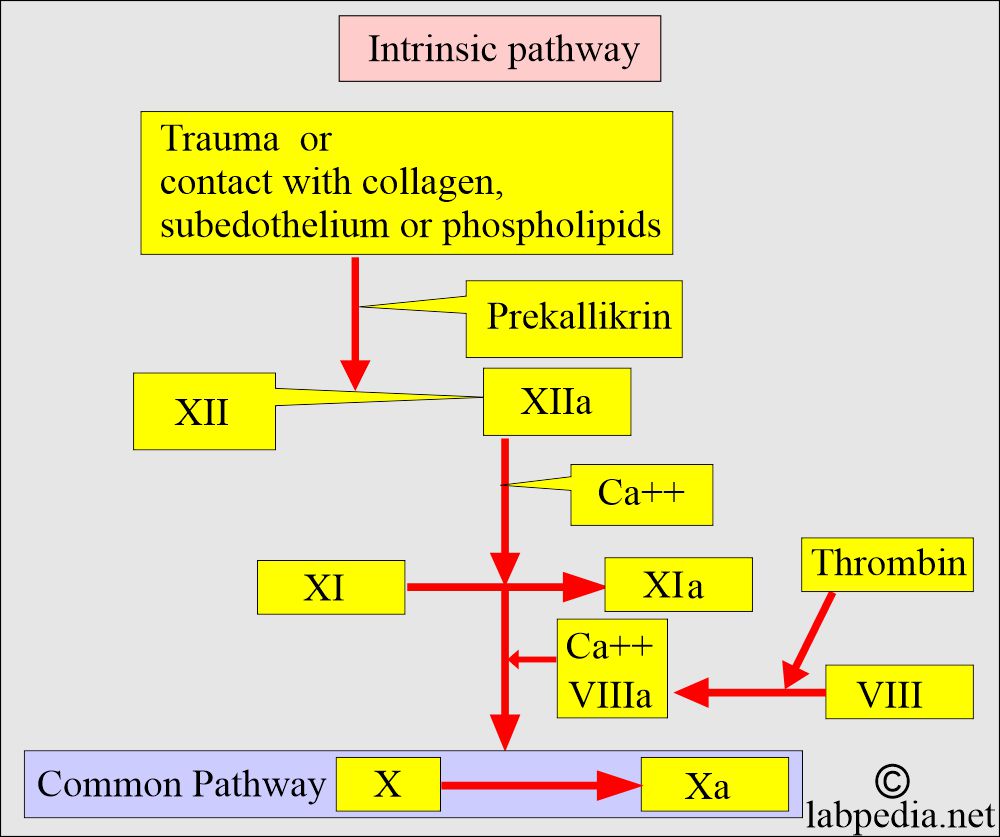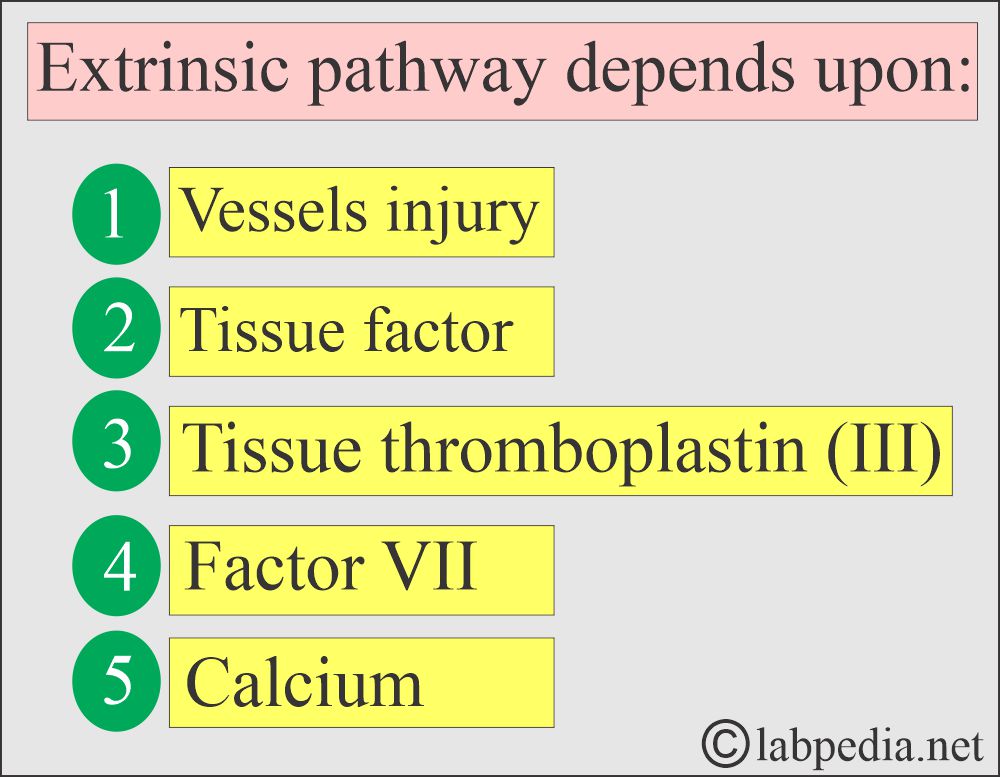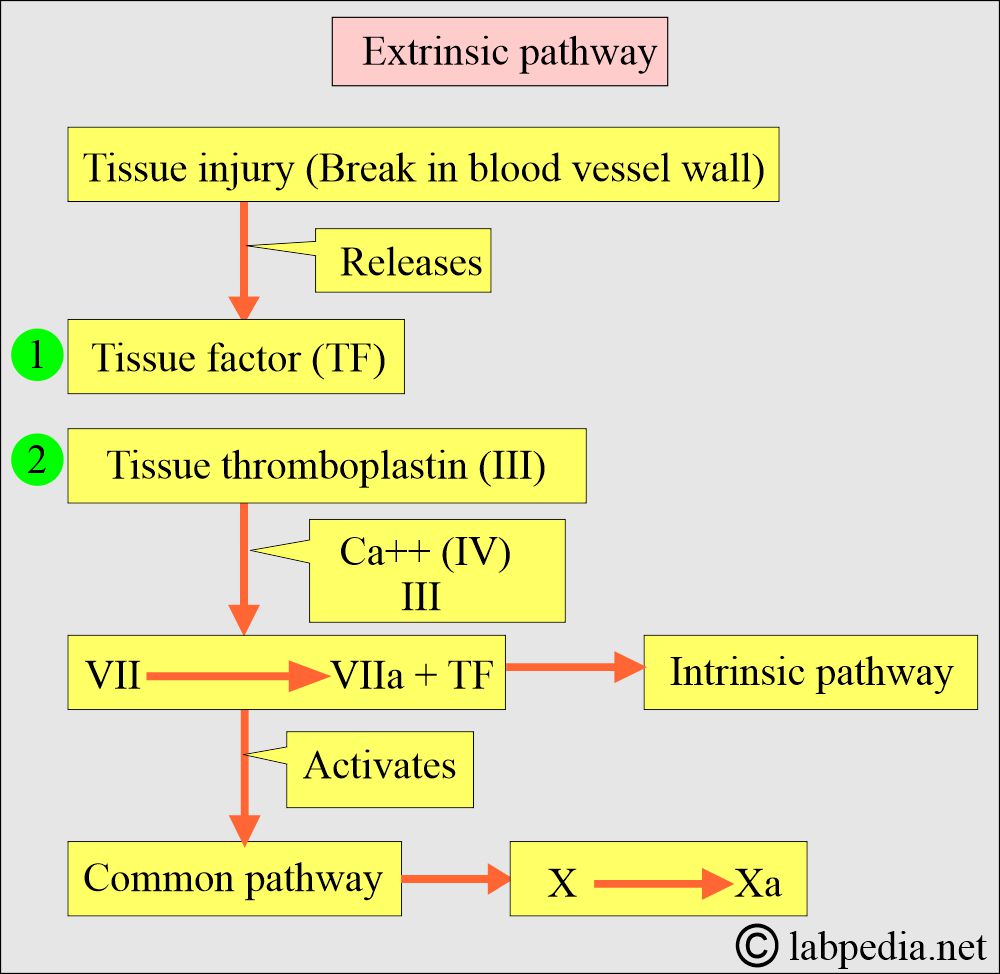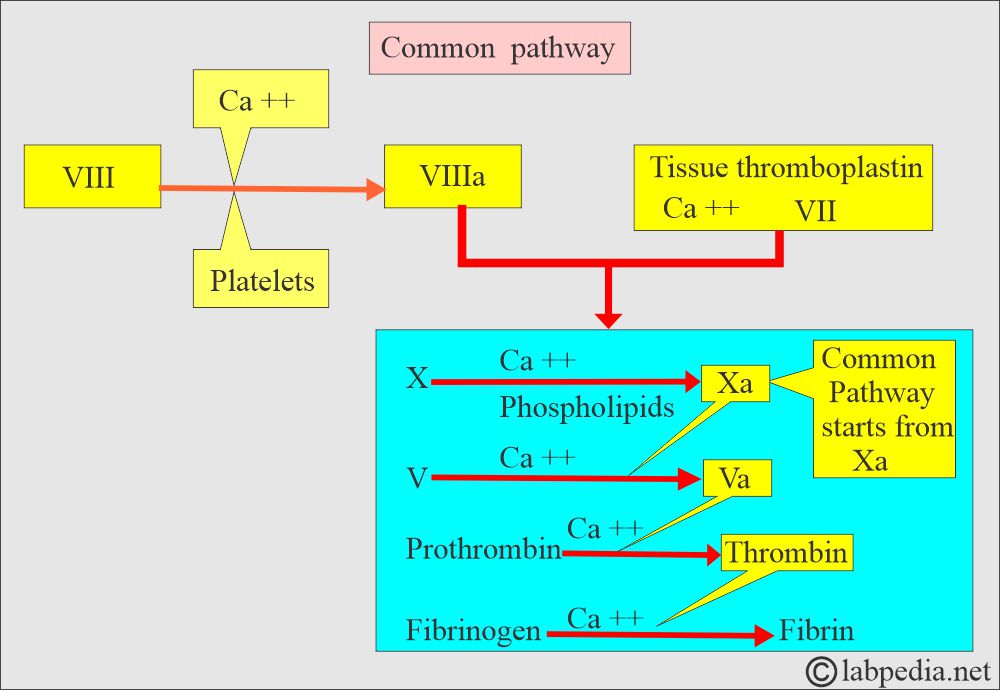Coagulation:- part 1 – Blood Coagulation process, Coagulation factors, and factors deficiency
Blood Coagulation Process
What sample is needed for Blood Coagulation studies?
- If the plasma is needed, take 5 ml of venous blood and add sodium citrate as the anticoagulant.
- Perform the assay immediately or as soon as possible.
- For factors II, V, VII, and X, place the citrated plasma on ice immediately, and the sample is stable for 2 hours.
- Freeze if it is delayed >2 hours.
What are the Indications for Blood Coagulation studies?
- To measure the coagulation factor concentration in the blood.
- To find the inherited or acquired bleeding disorders.
- If there is a history of bruises or excessive bleeding.
- If there is prolonged PT or PTT.
- Acquired conditions like Vit. K deficiency or liver disease.
- It may be advisable to monitor the treatment of a patient with factor deficiency.
How will you define the blood coagulation process?
- Blood coagulation is a process that involves a series of biochemical reactions, transforming blood coagulation factors into an insoluble gel through the conversion of soluble fibrinogen into fibrin.
- The body’s first reaction to bleeding is to constrict the blood vessels.
- This will be effective in small blood vessel injuries but not in large blood vessels.
How will you divide blood coagulation factors based on physical characteristics?
- Contact proteins:
- Hageman factor (XII).
- Plasma thromboplastin component (XI).
- Prekallikeri (PK).
- High-molecular-weight kininogen (HMWK).
- Prothrombin protein:
- Prothrombin (II).
- Stable factor (VII).
- Christmas factor (IX).
- Stuart-Power factor (X).
- Fibrinogen group:
- Fibrinogen (I).
- Labile factor (V).
- Antihemophilic factor (VIII).
- Fibrin stabilizing factor (XIII).
How will you describe the Blood coagulation process?
- The blood coagulation process involves:
- A series of biochemical reactions.
- It transforms circulating substances into an insoluble gel.
- This gel is formed by the conversion of fibrinogen to fibrin.
- This whole process needs blood coagulation factors, phospholipids, and calcium.
- The blood coagulation process consists of:
- Extrinsic pathway.
- Intrinsic pathway.
- In blood vessel injuries, the clotting factors are activated to plug the injured site.
What are the phases of the blood coagulation process?
The first stage, the primary phase:
- It is initiated by platelet aggregation.
- Platelets adhere to collagen and undergo shape changes.
- Platelets degranulate and release:
- Ionized Ca++.
- Magnesium.
- Serotonin.
- Epinephrine.
- Phosphate.
- ADP and ATP.
- Alpha granules release fibrinogen, platelet-derived growth factor, plasminogen activator inhibitor, albumin, β-thromboglobulin, fibrinonectin, and factor V (absorbed from plasma).
- The release of these chemicals leads to secondary aggregation, which is irreversible.
- Ultimately, platelets change shape and adhere to each other.
The second stage, the secondary phase:
- It is the activation of clotting factors.
The third stage, in Phase Three:
- Factor X is activated by proteases (VIIa, IXa, and XIIIa).
- Va can activate IX and X directly.
- The above reaction is responsible for thrombus formation.
- The adherent and aggregated platelets release factor V and expose factor 3, accelerating the coagulation process.
- It will stabilize the platelet plug with a fibrin clot.
What are the blood coagulation pathways?
The intrinsic pathway:
- It is initiated by foreign substances like collagen, subendothelium, or phospholipids, which will activate factor XII, involving contact factors and factor XI.
- Where factor XII and other proteins form a complex on the injured endothelium.
- XII
 XIIa
XIIa  XI to XIa and form a complex of VIII + XI + X.
XI to XIa and form a complex of VIII + XI + X. - Activated Xa is formed.
- Then, the common pathway starts.
The extrinsic pathway:
- It is a complex formation between the Tissue factor (factor III or thromboplastin) and factor VII.
- Activated factor VIIa forms, which stimulate factor X.
- Alternatively, factor VIIa activates factors IX and X.
Common pathway:
- The common pathway begins with the activation of factor X through either extrinsic or intrinsic pathways, or both.
- (Xa) converts Prothrombin to Thrombin (active form) in the presence of factor V, calcium, and phospholipids on the surface of platelets.
- Thrombin converts Fibrinogen to Fibrin, which polymerizes into a stable clot.
- Thrombin also activates factor VIII to stimulate platelet aggregation and fibrin polymerization.
- Prothrombin is a Vit K-dependent factor.
- Plasmin degenerates the fibrin polymer into fragments that are taken up by the phagocytic cells.
- Fibrinogen is considered an acute-phase protein and is increased in many diseases.
What are the normal values of clotting factors?
| Factors | Normal value Source 1 | Normal value Source 2 | Normal value Source 3 |
|
|
|
|
| Quantitation of the minimum hemostatic level mg/dL | Plasma concentration | ||
|
|
|
|
|
|||
|
|
||
|
|
|
|
|
|
||
|
|
|
|
|
|
|
|
|
|
|
|
|
|
|
|
|
|
|
|
|
|
|
|
|
|
||
|
|
||
|
|
||
|
|
- Reference values are different from various sources.
What are the causes of deficiency of blood coagulation factors?
- Inherited genetic defects.
- Acquired.
- Drug therapy.
What are the causes of acquired factor deficiency?
- Snake venom.
- Liver diseases.
- Uremia.
- Vit. K deficiency.
- Anticoagulant ingestion of warfarin.
- Massive blood transfusion.
- Some of the cancers.
- Disseminated intravascular coagulopathy.
- There is a balance between the factors leading to clotting and the factors causing dissolution.
What is the relationship of blood coagulation factors with other diseases?
- Factor XII deficiency was observed as an increased risk of Myocardial infarction and venous thrombosis.
- Fibrinogen is also considered a coronary risk factor that leads to stroke.
- Determine the exact factor deficiency for the replacement therapy.
Fibrinogen:
What are the causes of Fibrinogen level increase?
- Acute inflammatory reactions.
- Trauma.
- Coronary heart disease.
- Cigarette smoking.
What are the causes of decreased fibrinogen levels?
- Liver diseases like hepatitis and cirrhosis.
- DIC (disseminated intravascular coagulopathy).
- Fibrinolysis.
Prothrombin:
What are the causes of decreased Prothrombin levels?
- Vit. K deficiency.
- Liver disease.
- Oral anticoagulants.
- Circulating inhibitors or lupus-like anticoagulants.
- Decreased synthesis.
Factor V deficiency:
What are the causes of Factor V deficiency?
- Liver diseases.
- Factor V inhibitor.
- Myeloproliferative disorders.
- DIC and fibrinolysis.
- Mild decrease in the newborn.
Factor VII deficiency:
What are the causes of Factor VII deficiency?
- Liver diseases.
- Kwashiorkor.
- Normal newborn.
- Treatment with coumarin-like drugs.
Factor VIII:
What are the causes of increased Factor VIII?
- Late normal pregnancy.
- Thromboembolic conditions.
- Liver diseases.
- Postoperative patients.
- Normal newborn.
- Rebound phenomenon after sudden stoppage of coumarin-like drugs.
What are the causes of Factor VIII deficiency?
- Due to the presence of factor VIII inhibitors.
- DIC.
- Von Willebrand disease.
- Myeloproliferative disorders.
Factor IX:
What are the causes of Factor IX deficiency?
- Liver diseases and cirrhosis.
- Nephrotic syndrome.
- Anticoagulant antibody formation.
- Normal newborn.
- Drugs like Dicoumarol.
- DIC.
- Vit K Deficiency.
Factor X:
What are the causes of Factor X deficiency?
- Vit K deficiency.
- Liver Diseases.
- Oral anticoagulants.
- DIC.
- Amyloidosis.
- Normal newborn.
Factor XI:
What are the causes of Factor XI deficiency?
- Liver diseases.
- Intestinal malabsorption leads to Vit K deficiency.
- DIC.
- Newborn.
Factor XII:
What are the causes of Factor XII deficiency?
- Nephrotic syndrome.
- Liver diseases.
- Chronic myelocytic leukemia.
- Normal newborn.
Factor XIII:
What are the causes of Factor XIII deficiency?
- Postoperative patients.
- Liver diseases.
- In a persistently increased fibrinogen level.
- Acute myeloid leukemia.
- DIC.
- Circulating anticoagulants.
What are the causes of coagulation factor deficiency?
| Disease | Factors deficiency |
|
|
|
|
|
|
|
|
|
|
|
|
|
|
|
|
Questions and answers:
Question 1: What oral contraceptives cause factor deficiency?
Question 2: What will be the fibrinogen level in DIC?


